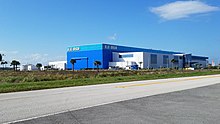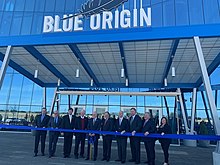Blue Origin facilities
TheprivateaerospacecompanyBlue Originhas a number of development, manufacturing, and test facilities in fourUSstates:Washington,Texas,Florida,andAlabama.
Blue Origin began in 2000 with only adevelopmentand office facility nearSeattle, Washington.By 2003 Blue Origin was buying land inwest Texasfor arocket enginetest facilityand, subsequently, for asuborbitalrocket launch site.[1] Blue Origin is currently developing a neworbitallaunch facility atCape Canaveral Space Force Stationand a nearby rocket assembly facility inBrevard County, Florida.[2]
Development facility and headquarters
[edit]The company is headquartered on 11 hectares (26 acres) of industrial land inKent, Washington,a suburb ofSeattle,where its research and development is located. The facility was 24,000 m2(260,000 sq ft) in size in early 2015,[3]growing to 28,000 m2(300,000 sq ft) by March 2016 with Blue Origin leasing additional space in adjacent office buildings. As of March 2016[update],the Kent facility housed engineering, manufacturing and business operations and the majority of the 600-person[4]Blue Origin workforce, which grew from about 350 persons at Kent in May 2015.[3]They added an additional 42,630 m2(458,900 sq ft) of office, manufacturing and warehouse space to their headquarters facilities in 2016 and 2017.[5][6] In late 2017, Blue Origin purchased an additional 13 hectares (31 acres)—adding to their existing 11 hectares (26 acres)—of land on which they plan to build another 32,000 m2(340,000 sq ft) of facility in Washington state.[7]
Florida facilities
[edit]This section needs to beupdated.(May 2021) |

In September 2015, Blue Origin leasedLaunch Complex 36(LC-36) inCape Canaveral,Floridato build a launch pad for theirorbitallaunch vehicleNew Glenn.As of March 2016[update],the first Blue Origin launch from LC36 was planned for 2020. An August 2015 estimate predicted that initial launch happening earlier than 2020.[8]Ground-breaking for the facility to begin construction occurred in June 2016.[9]By March 2018, Blue's construction at LC-36 was lagging, but the company stated they did not think it would delay achieving the anticipated 2020 initial launch ofNew Glenn.[10]However as of 2022 Blue Origin does not expect to launchNew Glennuntil 2023 at the earliest.[11]The factory was complete by 2020 and was being used for the construction ofNew Glennprototypes by 2021.[12]
The Blue Origin orbital launch site will be situated on a total of 306 acres of leased land assembled from former Launch Complexes 11, 36A, and 36B. The land parcel will be used to build arocket enginetest standfor theBE-4engine, alaunch mount—called the Orbital Launch Site by Blue—and a reusable booster refurbishment facility for theNew Glennlaunch vehicle,which is expected to land on a seaborne platform and returned toPort Canaveralfor refurbishment.
In addition, the manufacturing of "large elements, such as first stages, second stages, payload fairings, etc." will occur at the Blue Origin launch vehicle factory on Space Commerce Parkway in nearbyExploration Park,near the entrance to theKennedy Space Center Visitor Complexon Merritt Island.[13]
Landing platform ship
[edit]In October 2018,Stena Freighter,182 meter cargo-ship purchased from ferry operatorStena Line,arrived in Florida from Spain. CEO Bob Smith, confirmedStena Freighterwould be used as thelanding platform vesselfor first-stage boosters.[14]The landing ship will be hydrodynamicallystabilized.[15]
Launch Site One suborbital launch and engine test site
[edit]Blue Origin has a suborbital launch facility known asLaunch Site One.It is located in theWest Texasregion, 25 miles north of the town ofVan Hornat31.451646°+N, -104.762835°+W.Currentlaunch licenseand experimental permits from the US governmentFederal Aviation Administrationauthorize flights of Blue Origin's New Shepard suborbital system.[16]In addition to the suborbital launch pads, the West Texas site includes a number ofrocket engine test stands.Engine test cells to support bothhydrolox,methaloxandstorablepropellant engines are present.
Included are three test cells just for testing the methalox BE-4 engine alone: two full test cells that can support full-thrust and full-duration burns, as well as one that supports short-duration, high-pressurepreburnertests, to "refine theignition sequenceand understand thestart transients."[17]

Alabama engine manufacturing facility
[edit]In June 2016, Blue Origin presidentRob Meyersonannounced that they would build a new 600,000sqft facility inHuntsville, Alabamacalled “Blue Engine” to manufacture the largeBE-4cryogenicrocket engineand theBE-3engine.These engines will be tested at theNASA Marshall Space Flight Centeron the Test Stand 4670.[18]
References
[edit]- ^ Mylene Mangalindan (10 November 2006)."Buzz in West Texas is about Jeff Bezos space craft launch site".The Wall Street Journal.Retrieved28 May2008.
- ^ Price, Wayne T. (12 March 2016)."Jeff Bezos' Blue Origin could change the face of space travel".Florida Today.Retrieved13 March2016.
- ^ab "Local engineers aim high for cheaper spaceflight".Seattle Times.31 May 2015.Retrieved1 June2015.
- ^ Foust, Jeff (8 March 2016)."Blue Origin plans growth spurt this year".SpaceNews.Retrieved13 March2016.
- ^ Stile, Marc (20 October 2016)."Bezos' rocket company, Blue Origin, is the new owner of an old warehouse in Kent".bizjournals.Puget Sound Business Journal.Retrieved16 February2017.
- ^ "Jeff Bezos' Blue Origin space venture has plans for big expansion of Seattle-area HQ".GeekWire.22 February 2017.Retrieved11 August2017.
- ^ Boyle, Alan (28 December 2017)."Blue Origin space venture spends $14M on space for offices and warehouse in Kent".GeekWire.Retrieved20 January2018.
- ^Gebhardt, Chris (8 October 2015)."Canaveral and KSC pads: New designs for space access".NASASpaceFlight.Retrieved9 October2015.
- ^Blue Origin's Rocket Factory Breaks Ground, June 2016,accessed Feb 2022
- ^Foust, Jeff (19 March 2018)."A changing shade of Blue".The Space Review.Retrieved31 May2018.
construction at LC-36. The Air Force... limits work that can be done on "critical days" around launches, to avoid construction work that could cause mishaps—broken pipelines or severed cables—that would delay those launches. "Part of building is that you've actually got to be able to put a shovel into the ground", Henderson said. "On a critical day at Cape Canaveral you cannot break the surface of the ground". The number of critical days has been growing, in part because of increased launch activity. In 10 of the previous 12 months, he said, more than half of the work days were deemed critical days. "It's nearly impossible to build a project under those kinds of constraints".
- ^"Vulcan Centaur on schedule for first launch in 2022 as New Glenn slips".SpaceNews.23 March 2022.Retrieved13 June2022.
- ^New Glenn Factory Progress Update,retrieved13 June2022
- ^Bergin, Chris; Munson, Noel (29 March 2017)."Blue Origin working towards making the Cape its Orbital Launch Site".NASASpaceFlight.Retrieved20 January2018.
- ^"Blue Origin will be Landing its Rockets on a Used Cargo Ship. It'll Get Converted in Time for First Flights in 2021 - Universe Today".Universe Today.28 October 2018.Retrieved6 November2018.
- ^"Blue Origin publishes New Glenn overview as pad and landing ship continue development".NASA Space Flight.28 November 2018.Retrieved17 December2018.
- ^Final Supplemental Environmental Assessment for the Blue Origin West Texas Launch Site(Report). Federal Aviation Administration. February 2014.Retrieved3 May2015.
- ^"BE-4 Engine Testing Update From Jeff Bezos – Parabolic Arc".Parabolic Arc.
- ^ "Why is Jeff Bezos building rocket engines in Alabama? He's playing to win".Retrieved11 August2017.
